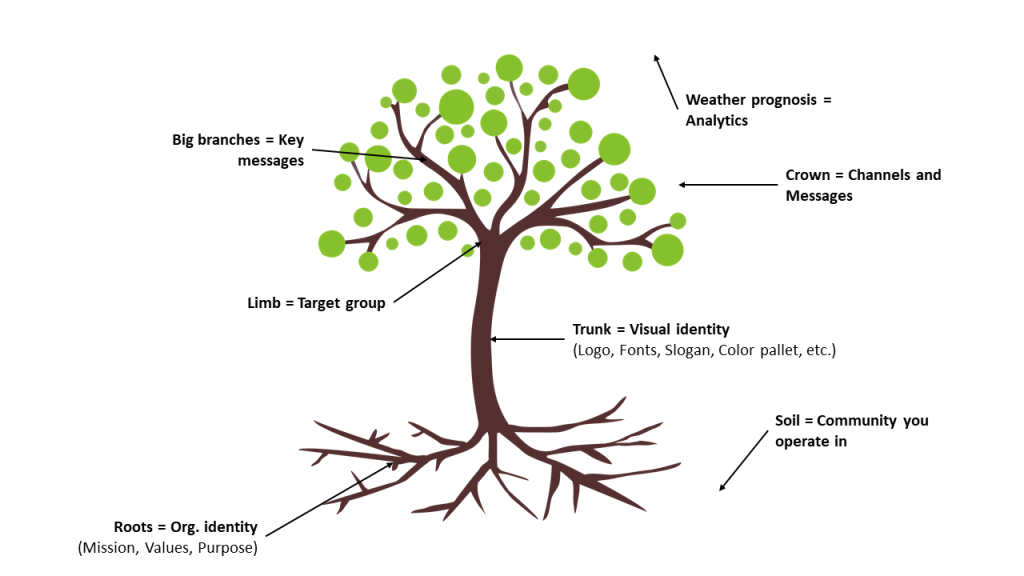They say nature is the best teacher for those who listen.
This is what inspired us to use one of its glorious inventions to explain the method of creating an external communication strategy model step by step and without (too much :D) stress.
In this guide we used the eco system of a tree to symbolize the process of developing a communication strategy.
Each part of the tree covers a specific part of the process, yet their full potential is realized only when they are constructed and used together to achieve a determined communication goal.

So how is a tree similar to a communication strategy?
It is long lasting.
It’s stabile and sturdy.
It changes and adapts.
It strives to achieve its ultimate goal – to grow.
On the pages that follow we will deep dive into each section with the intention to explain its meaning, importance and how you as an organization can benefit by using it.
ROOTS – ORGANIZATIONAL IDENTITY – WHY YOU NEED IT?
“People don’t buy what you do, they buy why you do it”
Simon Sinek
As there is no forth without back and no beginning without an end. All big trees, ideas, causes and successes have to start somewhere. Deep in the ground or in your imagination is the soil in which your organization’s identity is starting to form.
And this is a good thing.
Not only a good thing but a very important thing as research has confirmed many times over, that companies that were seen as having a stronger identity outperformed other and tend to win.
We believe that this is not related to the business model or profit per se but rather to the mechanisms of interaction found in any type of organization and that it is safe to say that this applies for any group of people gathered around a shared goal – from family to NGO.
So, if you were asking…

https://knowyourmeme.com/memes/y-tho
…this is that reason why.
When an organization has a strong identity it’s employees, it’s volunteers, it’s users and even it’s donors are more engaged to work towards the joint purpose.

Obviously this is not an exclusive ingredient for success but it seems to prove that it is a necessary one.
Figure 4 – Why identity is important for an organization? Source: Internal
ROOTS – ORGANIZATIONAL IDENTITY – HOW TO MAKE IT?

“Would you tell me, please, which way I ought to go from here?”
“That depends a good deal on where you want to get to,” said the Cat.
“I don’t much care where” said Alice.
“Then it doesn’t matter which way you go,” said the Cat.
“So long as I get SOMEWHERE,” Alice added as an explanation.
“Oh, you’re sure to do that,” said the Cat, “if you only walk long enough.“
Lewis Carroll – Alice’s Adventures in Wonderland
Figure 5 – Alice in Wonderland. Source: http://thomaskinkadehq.com/product/alice-in-wonderland/
Do you have a mission and vision statement? Do you have written and shared values or something you call purpose?
How have you been using it inside and outside of your organization?
-
How has it helped you attract volunteers or funding?
-
Has it helped you develop content for communication with your audience?
-
Or find some new channels to communicate to them?
This part we already covered in Internal MakeOver toolkit, leading you through the process of upgrading/defining your organizational values, mission and vision. In case you skipped that part, here we are bringing you back since it is as well essential element of developing successful communication strategy. Or in case you already did it, going through next couple of pages will provide you maybe with some more ideas.
The process of your external makeover will follow these stages:
-
Determining Your Identity – introspective into the purpose of existence, principal values and objectives of the organization-creating the mission and vision and values;
-
Designing Your Identity – giving shape, words, colors to your passion;
-
Communicating Your Identity – figuring out your audience and the best way to approach them. Also knowing that your identity comes across from all your assets – from your offices to your employees, to your FB page;

All of these steps are equally important and will serve your communication objectives and “business” plans.

They are also interconnected like layers on a cake or floors on a building and to get the final one right you will need to have a proper sustainable base – your mission, vision and values of your organization.
Mission and vision will serve you to:
✏ Externally:
-
Inspire your audience and generate support for your cause;
-
Communicate goals to stakeholders;
✏ Internally:
-
Improve Clarity;
-
Be able to Measure your progress;
-
Provide strategic direction;
-
Help with what to Focus on (important/not important);
-
To increase longevity – show goes on even if staff changes because there is a common guideline.

There’s no particular value in a mission or vision statement itself. There is, however, great value in actually using your mission or vision statement to generate discussions about how well (or not) the organization is doing in fulfilling that mission and vision.
